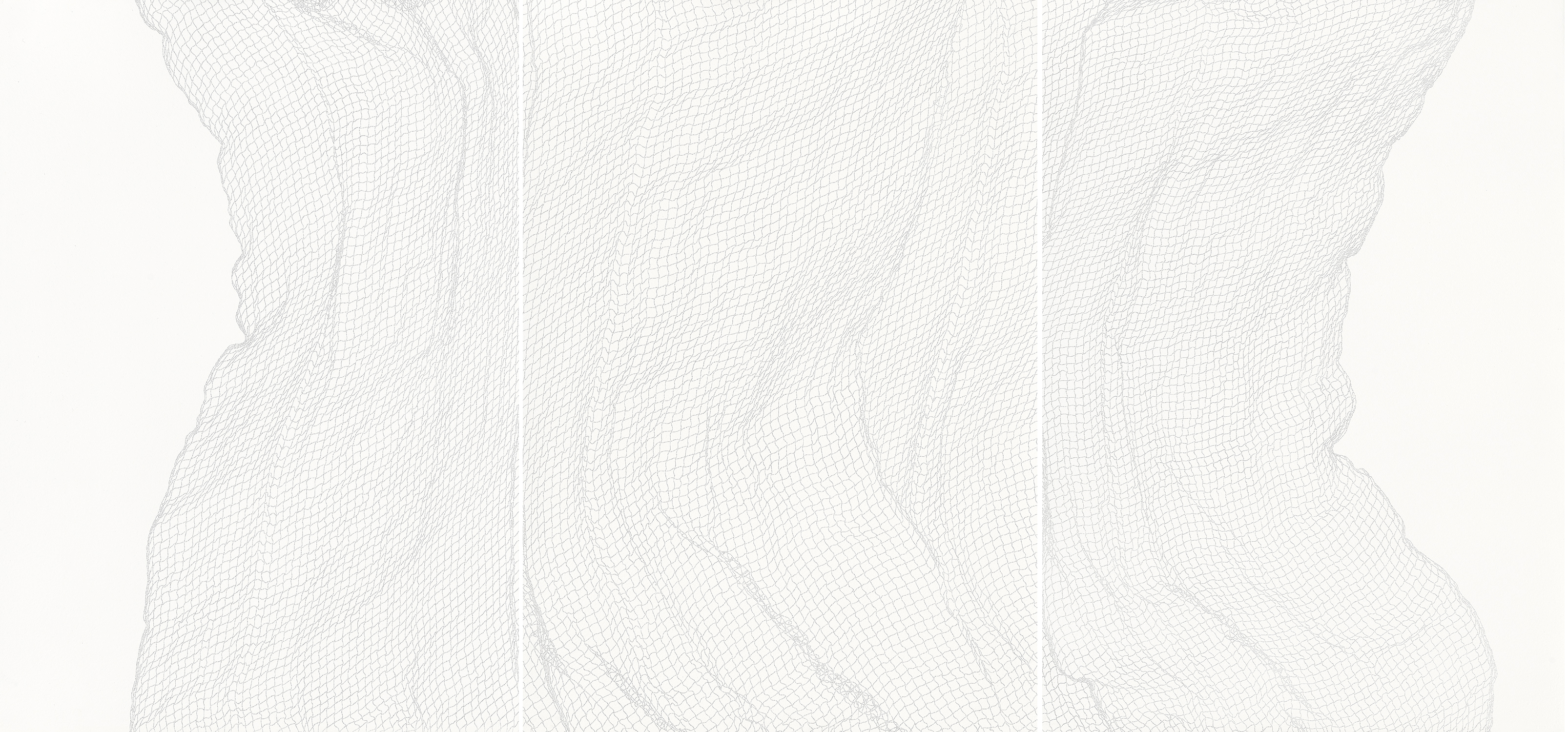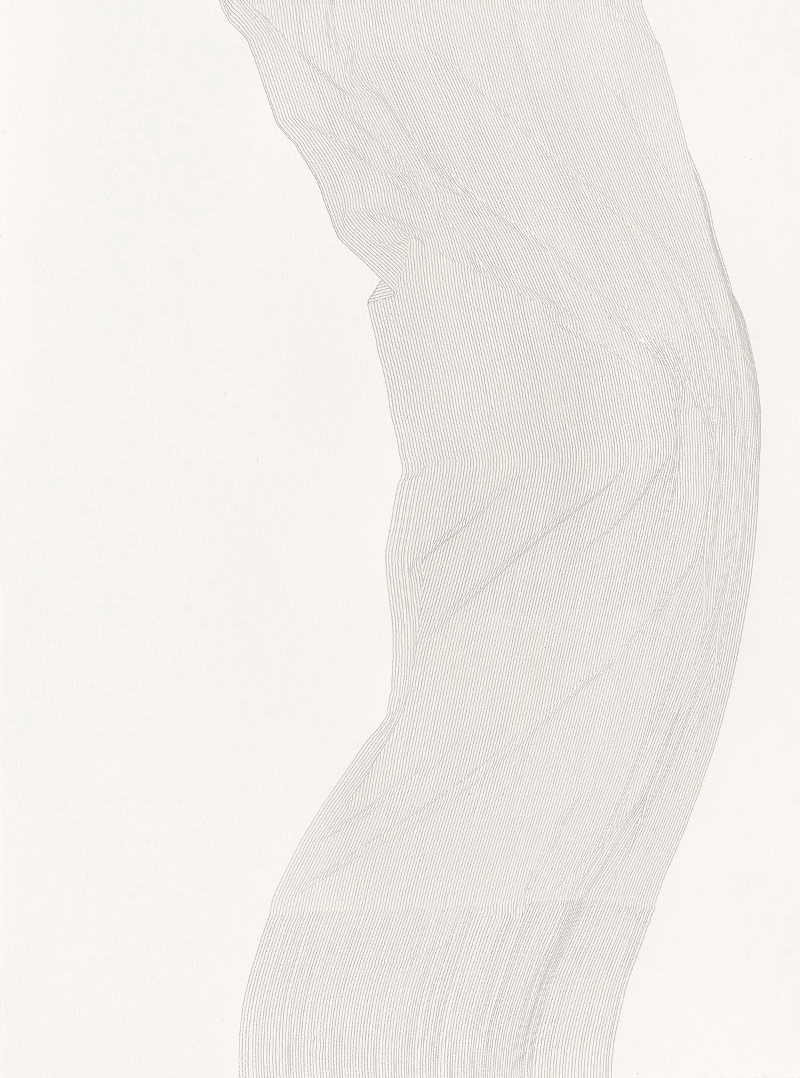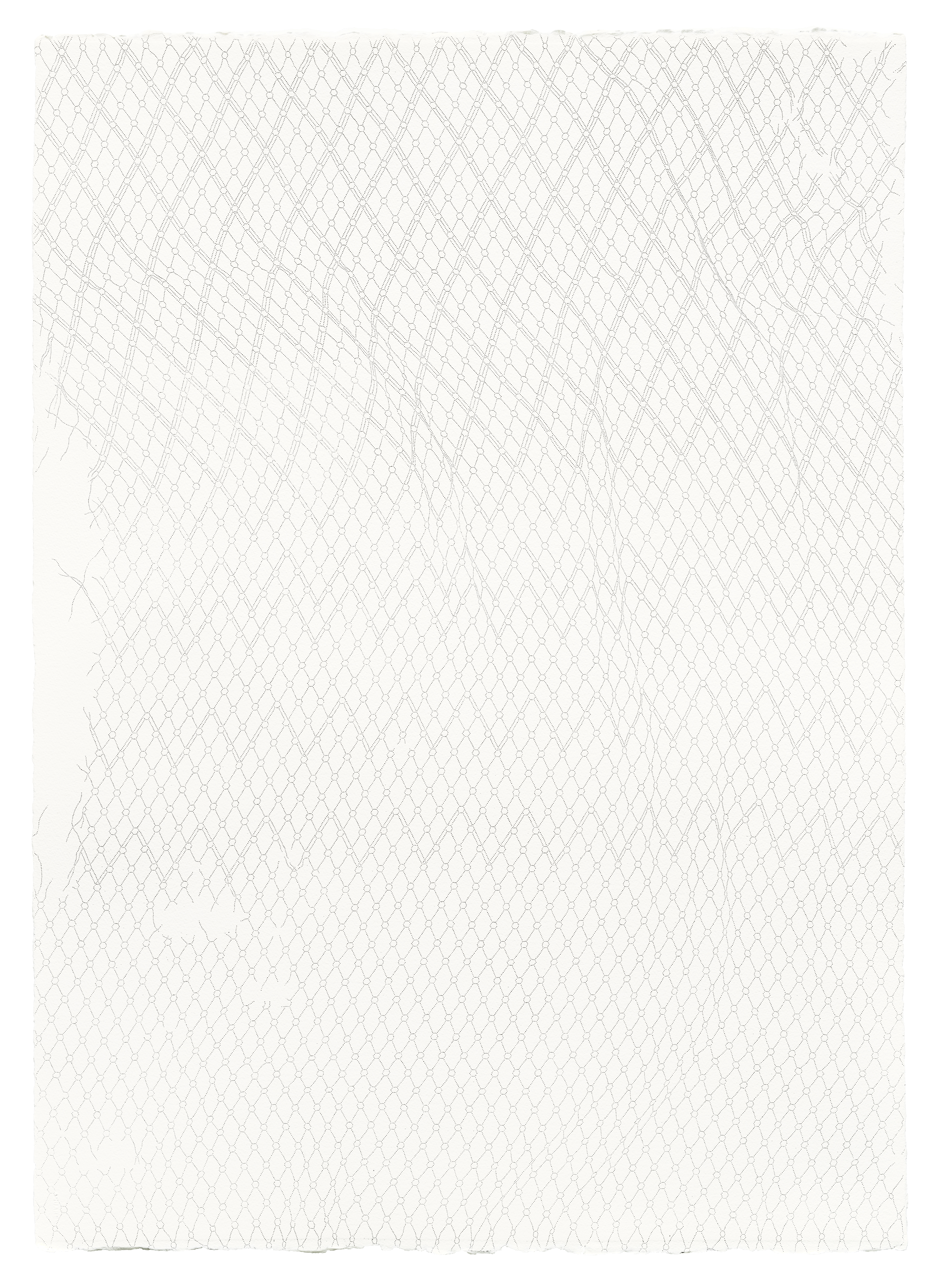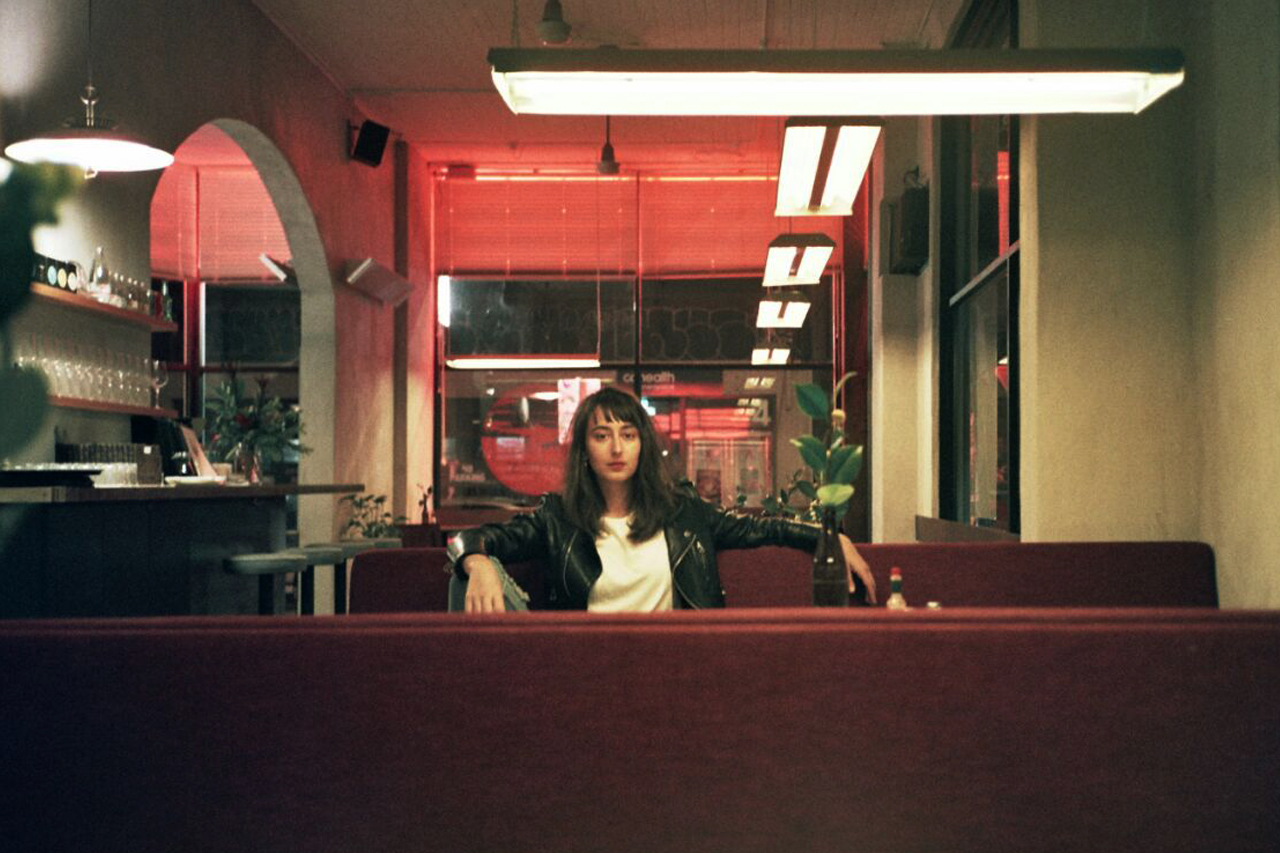
(Photo: Miso)
Head bent, ribbons of dark hair falling onto her work, 28-year-old Stanislava Pinchuk methodically hammers an awl into a blank sheet of paper, hitting the tool sharply over and over again. The dull clatter is suggestive of woodworking, but the art that Pinchuk creates is far more delicate: yards and yards of pinholes, or “drawing with nothingness,” as she describes it. The result is reminiscent of a subtly patterned, clean, white cloth. Descended from lace-makers, she draws inspiration from lacework, embroidery, and weaving. These mediums, traditionally thought of as “women’s work,” she says, can be deceptively technical, labor-intensive, and physically painful. The meticulousness of the process gives her ample time to think about what she is making, and why.
Pinchuk, or Miso, as she is also known, works out of a studio in Melbourne, Australia, although she spends most of her free time in Japan and other countries. In 2013, the National Gallery of Victoria acquired two of her pinprick works, making her one of the youngest artists featured in the collection. Since then, Miso has received accolades not just in the fine arts, but also for the intricate stick-and-poke tattoos that she trades with friends (including United Kingdom pop stars Sam Smith and Florence Welch), and with people she meets in her travels. In exchange for a home-cooked meal, a bottle of whiskey, a painting—anything but money—she adorns their skin with tiny constellations, symbols, or minimalistic maps, such as the outline of a daily commute. She is also known for hand-painting custom leather jackets for celebrity clients, such as Gigi and Bella Hadid, Kendall Jenner, and Cara Delevingne.
As the end of her twenties—the decade in which the art world first recognized her as a serious artist—draws nearer, another milestone far outshines it. This spring Miso completed the final installment of a trilogy she has worked on over the past three years. Each of the three installations (titled “Surface to Air,” “Fallout,” and “Sarcophagus”) includes vast paper “tapestries” that catalogue places on Earth that have known trauma: Ukraine, Fukushima, and Chernobyl, respectively. Visually, the hand-hammered pinholes in these works mimic the stitches of a woven tapestry. But, indecipherable to the viewer, the holes also act like data-points scattered on a plot—each one representing a piece of information, such as an elevation, radiation level, or a sound. These data are based on real measurements collected by Miso on site visits, while her more stylistic decisions are informed by her memories and dreams.*
“I’m quite mathematical in my work,” she says, speaking via Skype from the Scottish Highlands, where she is completing a three-month residency. As the Glenfiddich Artist in Residence, she has been living and working on the grounds of the Glenfiddich Whiskey Distillery in Dufftown, Scotland, using her surroundings to inspire new work.**
The first installment of her trilogy, shown in 2015, maps the topography of ever-changing borders and conflict sites in war-torn Ukraine through a series of paper tapestries. Miso was born in Kharkov, Ukraine, which, for the first three years of her life, was part of the USSR. The landscape where she grew up had been permanently altered by civil war, famine, and Nazi occupation. Since she moved to Australia at the age of 10, her homeland has been further riven by conflict. The name of the installation, “Surface to Air,” is a double entendre—referring to surface-to-air missiles developed during World War II, and to the idea of submerging and resurfacing emotionally as a response to trauma. The works themselves reflect this duality; some of the pin-pricked data maps are stylized to look like floaty, gently crumpled sheets of cloth, while others take the form of erratic, gestural slashes.

(Photo: Miso)
The following year, with “Fallout,” Miso chose to focus on Fukushima, the site of one of the largest nuclear disasters in world history. She was living in Tokyo in 2011 when an underwater megaquake hit Japan, triggering a massive tsunami. Power outages at three nuclear reactors near the earthquake’s epicenter shut down cooling systems, and the tsunami wiped out back-up generators, causing a nuclear meltdown. Hundreds of civilians died while evacuating the area, and thousands more (including about a dozen plant workers) could be affected by radiation exposure in coming decades. Seawater, which plant workers pumped in as a last-ditch effort to cool down the reactors, was found to have leaked back out, contaminating surrounding waters. Miso’s series of works in “Fallout” are functional, literally mapping the physical contours of the landscape. But unlike typical topographical maps, the dotted grid-lines designating each curve of the Earth’s surface are light and airy, designed to emulate the abandoned piles of fishnets she came across while visiting the site years later.
In some ways, Miso says that growing up in Ukraine prepared her for living in Japan following the disaster at Fukushima. “I was surprised by how ready I was,” she recalls. “I had an understanding of contamination and food supplies, and that Tokyo should have been evacuated.”
She says the experience unearthed a paranoia she had hidden away for years. To reconcile the flood of emotions, she returned home—to Ukraine, and, eventually, to Chernobyl.
In contrast to Fukushima, where there had been at least some semblance of tidying up, ground zero at Chernobyl’s Reactor 4—more than 30 years after a graphite fire spewed plumes of radioactive material into the atmosphere for nine days straight—is an abandoned, overgrown wasteland.
Miso says she headed straight to New York City after visiting Chernobyl, trying to distract herself from the weight of being in such a place, and from the dreams that still haunted her sleep every night. Many of her friends in the West, hearing about the fruit trees, mushrooms, and wasps that had returned to the area around the meltdown, seemed pacified by the idea of Chernobyl being “reclaimed by nature.”
“It enraged me,” she says, “because it hasn’t been ‘reclaimed.’ I remember it [before the disaster] as this incredibly bountiful land. We have a saying that if you drop a seed it’ll turn into an apple tree. German soldiers during World War II were taking truckloads of this earth back into Germany, that’s how fertile it is. And now there’s this really weird, invisible poison.”

(Photo: Miso)
Within this rage she found inspiration, visiting the Metropolitan Museum of Art obsessively, day after day, to view its collection of Egyptian textiles. For the final installment of her trilogy, entitled “Sarcophagus,” she would create just one work—the largest she’s ever made—a nearly 20-foot-long paper tapestry.
In form, it looks like a larger version of the works in “Fallout” and “Surface to Air,” with its undulating arrays of pinholes mapping the topography of Chernobyl’s ground zero. The edges of the grid, though, are stylized to look like the frayed threads of the Met’s ancient textiles, and there are pinprick illustrations of small rips and snags interspersed throughout. The tapestry is displayed like a museum artifact, set parallel to the ground in a glass case.
While Miso calls “Sarcophagus” a more abstract and more visceral work than those in her previous two installations, it feels deeply calculated, with several interconnected levels of meaning. The name refers to the metal-and-concrete shell that has encased the reactor’s core since the catastrophe, which has long been called a sarcophagus. Constructed haphazardly in the first 200 days of fallout, the sarcophagus began to crack in recent years—”as every nuclear vessel eventually will,” Miso says. Last fall, engineers slid a new, 40,000-ton steel hull overtop the sarcophagus to reseal it.

(Photo: Paul Stillen)
When visiting the site, Miso used a Geigometer to measure radiation levels at periodic points surrounding the newly face-lifted sarcophagus. She then translated these readings to the tapestry, representing high radiation levels with dense clusters of pinholes and low radiation levels with sparser clusters. The overall effect is a seamless, checkerboard pattern akin to loosely woven cloth. The work is meant to highlight what Miso sees as the plant’s negligence in protecting its employees and citizens of the world, and the Ukrainian government’s inept response.
In another sense, though, “Sarcophagus” harkens back to the Egyptian funeral shrouds at the Met. These shrouds, emblems of death, look almost indistinguishable, Miso says, from the lace bridal veils traditionally found in Ukrainian and other cultures. To her, this similarity highlights the symbiotic relationships between fertility, life, and death. Flanking the Egyptian textiles exhibit is an inscription about Ra, the Egyptian god of sun and bees, who “made life and death into arbitrary states,” Miso says, by dying each day at sunset, and “crying tears made of honey, which crystallize and preserve dead matter into living forever.” Still today, bees are sometimes called “tears of Ra.”
Some of Miso’s ancestors were beekeepers, so the symbolism behind the tears of Ra has a further, personal meaning to her. Before visiting Chernobyl, she read about how beekeepers were among the first to know the reactor fire had erupted, because their bees were behaving in a way they had never seen before: “They retreated into their hives and wouldn’t come out again.” According to oral histories, wasps fled completely for six years after the accident, before eventually returning home. Coincidentally, the Soviet government sometimes called its white-clad “liquidators“—the thousands of workers assigned to clean up after Chernobyl—”drones,” which is a beekeeping term (even though, in a bee colony, the drones mate with the queen and the female bees are workers). Wabi-sabi honeycomb shapes embedded in the grid pattern of the tapestry represent beekeeping activity that persists in the zone today.
“Sarcophagus” went on exhibit in late April at the China Heights Gallery in New South Wales, where the whitewashed floorboards of the gallery space echoed the stark whiteness of the tapestry, recalling the layer of radioactive ash coating every surface after the accident. Laid flat in its glass display case, the work runs roughly half the length of a London double-decker bus, each of its hand-formed pinholes a testament to the artist’s tenacity.
“It was backbreaking,” Miso says. But she felt, given the subject matter, it needed to be big. “It’s almost like an act of penance.”
*Update—July 24, 2017: This article has been updated to reflect Miso’s treatment of data more fully.
**Update—July 24, 2017: This article has been updated to reflect fuller details of Miso’s residency in Scotland.





